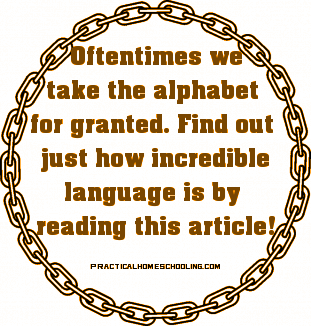 Most people take the alphabet for granted. It has been a part of our culture and civilization for so long that most people haven't the faintest idea of how or where it originated. Yet the idea of using abstract symbols - which we call letters - to stand for speech sounds is one of the greatest intellectual inventions in all of human history.
Most people take the alphabet for granted. It has been a part of our culture and civilization for so long that most people haven't the faintest idea of how or where it originated. Yet the idea of using abstract symbols - which we call letters - to stand for speech sounds is one of the greatest intellectual inventions in all of human history.
Prior to the widespread use of the alphabet, the earliest other known form of writing was pictography. Some people drew pictures on the walls of their caves, and in that primitive way they were able to communicate some simple stories. The pictures looked like the things they represented. An animal looked like an animal. A human being looked like a human being. A tree looked like a tree. You didn't have to go to school to be able to "read" these pictographs.
But as civilization became more complex, the scribes had to create graphic symbols that did not look like the ideas they were representing. For example, how could you draw pictures of such ideas as "system," or "determine," or "intuition"? You couldn't. So you drew a symbol and said that this symbol stands for "intuition." It didn't look like "intuition," but it was "intuition." The scribes created thousands of such symbols, and now you did have to go to school to be able to "read" these symbols. Somebody had to tell you what each of these symbols meant.
The Chinese people today still use such a writing system. A child in a Chinese school must memorize several thousand of these symbols in order to be able to read a Chinese newspaper. Each one of these symbols stands for a Chinese word. As a result, the development of the Chinese language has been somewhat handicapped by their writing system. We know that the Chinese people are highly intelligent, yet they lagged so far behind the West until recently when thousands of them have attended Western universities and learned English.
Which brings us to the origin of the alphabet. Sometime around 2,000 B.C. some remarkable individual in the area of what is now Southern Lebanon or Northern Israel made an unprecedented discovery. He discovered that all of human language was composed of a limited number of speech sounds which could be isolated and represented by graphic symbols. And so the first Alphabet was invented.
It is said that the Phoenicians invented the alphabet for commercial purposes. But that's too simple an explanation. A collective can invent nothing. I believe that the Alphabet is of divine origin. Let me explain. As we all know Moses was raised by an Egyptian princess, and so he was educated to read Egyptian hieroglyphics. But when he went up to Mount Sinai to receive the Ten Commandments from God, they were written in alphabetic Hebrew. The question is: Who taught God the Alphabet?
There is no doubt that the Alphabet was a gift of God whether it came to us directly from Him or through a human being. In any case, the alphabet made the Hebrews the People of the Book. It permitted the Hebrew scribes to write the Holy Scripture so that anyone who mastered the alphabet could read the Word of God.
The impact of the alphabet on ancient culture was revolutionary. It did for the ancient world what the computer has done for the modern world. One could now do so much more with so much less. Literacy was now so easy to achieve. All you had to do was learn the letter sounds, and with some drill and practice become a fluent reader.
The alphabet spread to Greece and Rome, and a result we have a huge legacy of ancient classics that are still read today. Different nations created their own alphabets: the Russians the Cyrillic alphabet, the Armenians their own alphabet, etc. But the one alphabet that is on its way to achieving universal use is the English alphabet.
Learning to read the English alphabetic system is quite simple. First you must learn to recognize the letters, then you must learn the sounds the letters stand for. In the old days, children were drilled in the consonant-vowel combinations - ba, be, bi, bo, bu - in learning the long vowels, and in vowel-consonant combinations - ab, eb, ib, ob, ub - in learning the short vowels. That drill permitted the child to develop the needed phonetic reflex.
If we want to restore high literacy in the United States, all the schools have to do is return to the teaching method that worked so well in the past.